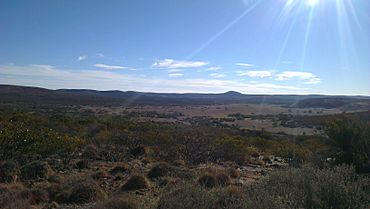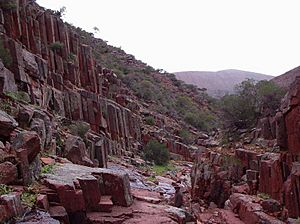Gawler Ranges National Park facts for kids
Quick facts for kids Gawler Ranges National ParkSouth Australia |
|
|---|---|
|
IUCN Category VI (Managed Resource Protected Area)
|
|

The Conical Hill Track
|
|
| Nearest town or city | Wudinna |
| Established | 15 January 2002 |
| Area | 1,628.75 km2 (628.9 sq mi) |
| Managing authorities | Department for Environment and Water |
| Website | Gawler Ranges National Park |
| See also | Protected areas of South Australia |
The Gawler Ranges National Park is a huge protected area in South Australia. It covers about 1,633 square kilometers (631 square miles). This amazing park is located about 350 kilometers (217 miles) north-west of Adelaide, on the northern part of the Eyre Peninsula. It's famous for its incredible and unique rock formations.
Contents
The Park's Story: How it Began
The Gawler Ranges National Park started out as a large sheep and cattle farm called Paney Station. This farm covered about 1,200 square kilometers (463 square miles). In the year 2000, the South Australian Government bought this land. They had help from the Australian Government to do this.
Then, in 2001, another piece of land was added to the park. This was about 420 square kilometers (162 square miles) from a nearby farm called Scrubby Peak Station. This is how the national park grew to its current size, protecting its special environment.
Visiting the Park: How to Get There
The national park is located about 40 kilometers (25 miles) north of Wudinna. It's also about 40 kilometers (25 miles) north-east of Minnipa. To reach the park, you will need a vehicle with high ground clearance. This means a car that sits higher off the ground.
You can get to the park using gravel roads from towns like Kimba, Wudinna, or Minnipa.
- Camping: You are allowed to camp at several spots within the park.
- Facilities: Some camping areas have toilets, but there are not many other facilities.
- Be Prepared: Visitors should bring enough food, water, fuel, and firewood with them. This helps make sure you have a safe and fun trip!
Cool Places to See in the Park
The Gawler Ranges National Park has many interesting places to explore. Some of these spots have a lot of history. Others are just beautiful natural landmarks.
- Historic Sites: You can visit the Old Paney Homestead, which is an old farm house. There's also the Policemans Point precinct and Stone Dam. Pondanna Outstation is another historic spot where people tried farming a long time ago in the early 1900s.
- Natural Landmarks: Look out for impressive natural features like Paney Bluff, Mount Allalone, Mount Sturt, Conical Hill, and Scrubby Peak.
- Scenic Spots: Don't miss Kolay Mirica Falls, the unique rock formations called the Organ Pipes, and the beautiful Yandinga Gorge.
Amazing Animals and Plants
The Gawler Ranges National Park is home to many different kinds of animals and plants. It's a very important place for nature.
- Rare Species: About 21 rare and endangered animal and plant species live here.
- Yellow-footed Rock-wallaby: One special animal you might see is the yellow-footed rock-wallaby. These are small kangaroos that are very good at climbing rocks.
- Southern Hairy-nosed Wombat: Another larger mammal found in the park is the southern hairy-nosed wombat. These are strong, burrowing animals.
- Bird Paradise: Over 140 different types of birds have been seen in the park!
- Important Bird Area: Because of all the birds, the park is known as an "Important Bird Area" (IBA) by BirdLife International. This means it's a crucial place for certain bird populations. Some of the special birds here include:
- The malleefowl, which is a vulnerable species.
- A special type of short-tailed grasswren found only in the Gawler Ranges.
- The rufous treecreeper.
- The blue-breasted fairy-wren.
- The purple-gaped honeyeater.
- The western yellow robin.
See also
 In Spanish: Parque nacional Montes Gawler para niños
In Spanish: Parque nacional Montes Gawler para niños



